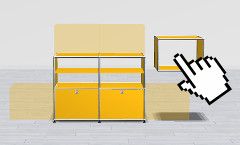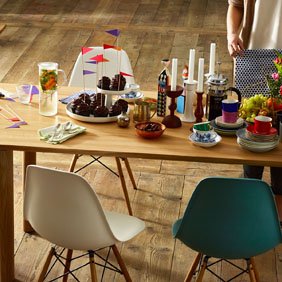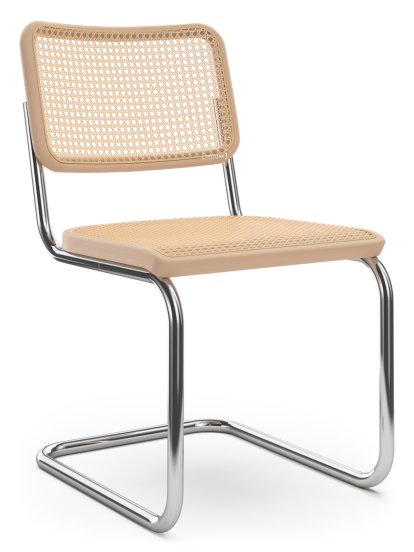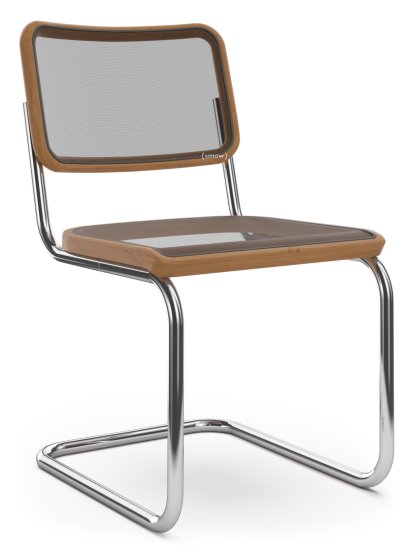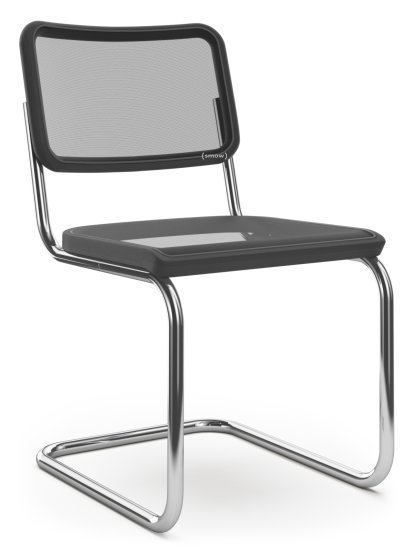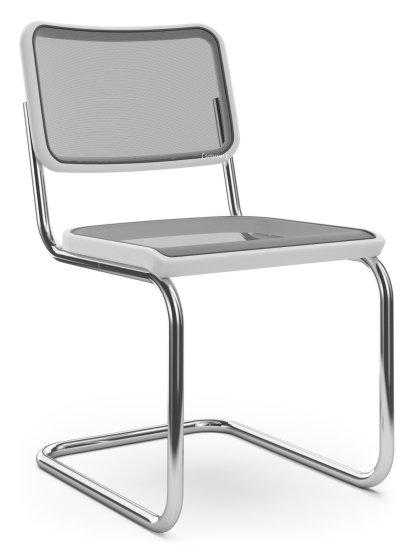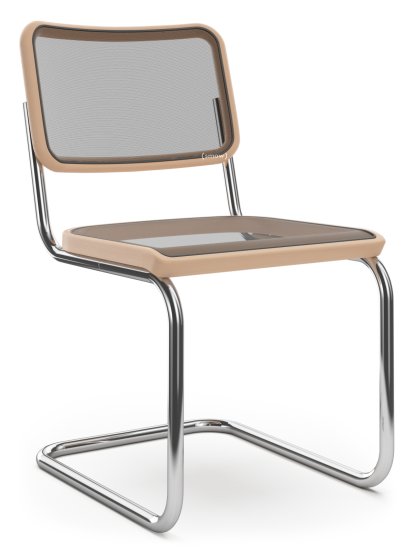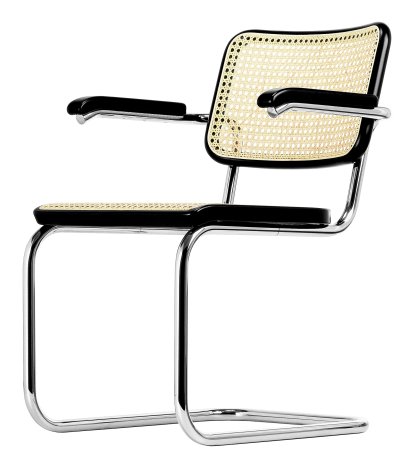S 32 / S 32 N Cantilever Chair, Cane-work (with supporting mesh underneath seat), Black stained beech, No glides

has been added to your wishlist.

Thonet classics at a special price – 15% discount on design icons
*The JS . Thonet collection is excluded

Bauhaus Promotion: Buy 6 Thonet Cantilever Chairs, Pay for Only 5
* Promotion applies to all models in the category Thonet Cantilever Chairs marked with "5 + 1". The promotional discount is a component of the overall purchase contract, in case of cancellation all further responsibilities are regulated by our Terms & Conditions.
Details
| Product type | Cantilever chair |
| Dimensions | 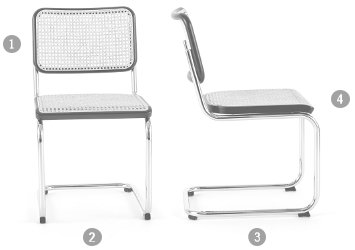 (1) Height: 82 cm (2) Width: 46 cm (3) Depth: 60 cm (4) Seat height: 46 cm |
| Weight | 5,8 kg |
| Material | Frame: Tubular steel, chrome plated Seat and backrest: wickerwork (with supporting tissue) or synthetic net weave Armrests: Beech, stained or white lacquered Glides (optional): plastic, black |
| Manufacturing | |
| Variants | Optionally available with synthetic netweave, black (S 32 N) or natural wickerwork (S 32) Optional felt glides for hard floors Separately available: S 64 / S 64 N with armrests S 32 N / S 64 N Pure Materials S 64 VDR Atelier with castors |
| Colours | Wood     Seat and backrest    |
| Function & Properties | As seats are usually exposed to heavy use, there is a transparent, plastic mesh (supporting tissue) underneath the the wickerwork in the seat. However, the chair can also be ordered without the supporting mesh. Not stackable |
| Care | Natural materials need special attention. The wickerwork should be regularly moistened on the rough bottom / back, to maintain its elasticity - this is especially important in dry and/or air-conditioned rooms. Dryness over a long time making the natural material brittle and susceptible to cracking. Should the wickerwork start to lose threads these can be attached with an adhesive. Subjecting the chairs to point specific heavy loads must be avoided. Please click on picture for detailed information (ca. 0,2 MB). 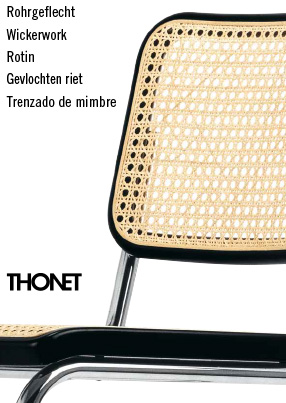 |
| Certificates & Sustainability | Thonet has declared sustainability to be a corporate principle. The manufacturer continuously optimizes all processes from production/technology, materials management and recyclability to transport routes and constantly pays attention to resource-saving energy and material consumption. Last but not least, social and ethical principles are among the top priorities. Thonet has been awarded the "Green Globe Certificate" for its measures of sustainable and environmentally friendly management - further information can be found here. |
| Warranty | 24 months |
| Product family | Thonet Cantilever Chairs |
| Datasheet | Please click on picture for detailed information (ca. 3 MB). |
| Product presentation |
FAQ
Is it possible to retrofit glides to an S 32/S 32 N?
A Thonet cantilever chair is specially produced to allow a retrofitting with plastic glides (transparent or black) with or without felt insert using the pre-punched drill holes, add an additional 11 mm to the overall height and cost 29,- EUR per set / chair.On older cantilever models produced before 2010, the Thonet frames were pre-punched as standard and the glides are installed as follows: With a 4.2 mm drill (available at any hardware store or as the special-hardened Thonet drill bits for Euro) bore holes in the marked locations. The felt pads can then be attached using the supplied self-tapping screws.
Is the S 32/S 32 N also available with armrests?
Yes, the version with armrests is the Thonet S 64
What is the supporting material under the seat of a S 32/S 32 N?
For chairs which are exposed to particularly heavy use, a transparent plastic mesh can be fitted under the wickerwork. The S 32 is however also available without the supporting tissue.

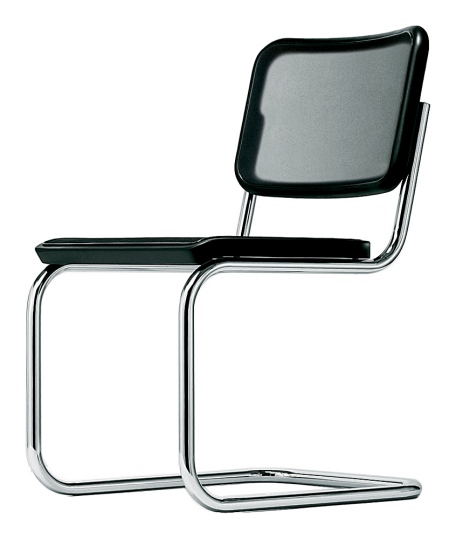
The Design
The cantilever chair represents a milestone in the history of furniture design. Officially recognised as being the work of Mart Stam, Marcel Breuer can also lay claim to having been involved in the development of this free-swinging Bauhaus era chair genre. In 1925 Breuer developed his bent steel tube Wassily Chair B3, it was however not until 1927 when Mart Stam and Ludwig Mies van der Rohe presented their cantilever chairs as part of the Weissenhofsiedlung exhibition in Stuttgart that the cantilever form was first presented to the public. In 1928 Breuer then presented his version, a chair since that has been produced since 1929/30 as the Thonet S 32 without armrests or S 64 with armrests, a chair also known as the Cesca chair. As with its relatives the Thonet S 32 is defined by its curved tubular steel frame, a construction which negates the need for a conventional four-leg construction and which gives the chair the its floating character. In contrast to other examples of the genre however, for his S 32 / S 64 Breuer used wickerwork for the seat and back, a material that once adorned Thonet's famous coffee house chair, thus creating a link between tradition and modernity in the Thonet history.
Regardless of questions of the authorship of the cantilever chair Marcel Breuer's chair as one of the great Bauhaus classics and still stands as a typical for the tubular steel furniture of the time and reflects the spirit of both the time and the Bauhaus school: even if, formally, it was created after Breuer departed Bauhaus. Steel tubing came from the industry and thus was suitable for furniture construction in addition to having the versatility demanded by modern furniture design, an industry looking to create affordable, functional and space-saving furniture for the masses. The design of the Thonet S 32 presents the typical reduced, clear form and rejects any kind of unnecessary ornamentation. The only decoration being the the shiny chrome layer on the steel tube, an aesthetic which gifts the chair an exceptionally elegantly Aura. The woven wickerwork meanwhile highlights the lightness of the cantilever and underscores the minimalist design concept.

Wickerwork being woven for at the Thonet factory in Frankenberg, Germany.
Production
The S 32 is built in the Thonet factory in Frankenberg/Eder, Germany. First the tubular steel frame is bent and chrome plated, for the frame an especially feathered precision steel alloy is used which will later allow for the supportive, load bearing effect. The wooden frame of the seat and back are made of natural or stained beech which is sourced from FSC or PEFC certificated forests. The wicker is made from rattan, a very robust material which on account of its quick growing periods makes it especially renewable and thus ecologically responsible. The woven mats are cut by hand and attached to the wood frame. To give greater stability to the wickerwork a barely visible plastic fabric is stretched underneath. As an alternative to cane the Thonet chair is also available with a black, semi-transparent plastic mesh covering.
Designer
The Cesca chair was designed by Marcel Breuer. Born in Pecs, Hungary in 1902 Breuer worked as architect and designer, in addition to both studying and teaching at Bauhaus, an institution he helped make one of the defining moments of classical modernism. Over the course of his career Marcel Breuer was responsible for numerous buildings and furniture designs, including many of the most popular steel tube designs in furniture history. Following the rise of the Nazis in Germany Marcel Breuer emigrated in 1937, first to his native to Hungary and later to London and subsequently the United States. In America he taught at Harvard and ran his own architectural practice, initially together with Walter Gropius, later alone. From 1946 Marcel Breuer worked exclusively as an architect and created an impressive oeuvre of architectural works, including the Whitney Museum, New York and the ski resort of Flaine in Haute-Savoie, France. Marcel Breuer died in New York on July 1, 1981.
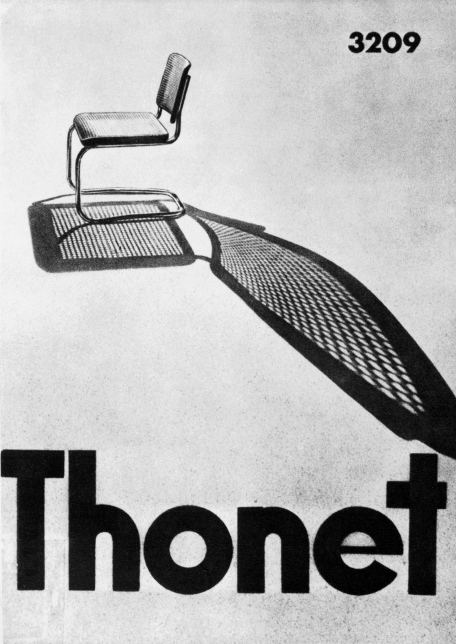
An original advertisment for the Thonet S 32
Manufacturer
Founded in 1819 as a construction and carpentry by Michael Thonet in Boppard am Rhein, Germany, Thonet became in the course of the next century one of the most important pioneers of the modern furniture design. With their bentwood furniture in the 1850s and the tubular steel furniture in the 1920s the company not only developed new processes for the mass production of furniture, but also established new aesthetic standards. Particularly noteworthy are the Vienna coffee house chair No. 14, and the cantilever chair designs by Marcel Breuer, Mart Stam and Ludwig Mies van der Rohe. The Breuer S 32 combines both characteristic Thonet styles with its steel tubular frame over which is stretched a wickerwork seat and backrest. Based in the German village of Frankenberg/Eder, the company is managed today by Peter Thonet, a direct descendant of company founder Michael Thonet. In addition to the Bauhaus and bentwood classics Thonet also produce contemporary designs by the likes of Stefan Diez and James Irvine.

Designer and architect Marcel Breuer
Historical Context
The inter-war years represented a period of economic renewal, and a period of new discovery in terms of furniture design and production processes. Following in the wake of the fantastic new opportunities bentwood had offered since the mid-19th century, it was now steel tubing which was to revolutionise the furniture world. Machinable, versatile in use, light and shiny, it was perfect for the new Zeitgeist of the Roaring Twenties, and a German society obsessed with art, culture and science. Inspired by the sight of a pair of bicycle handlebars, Marcel Breuer designed in 1925 the first chair using tubular steel; thus beginning his contribution to the development of a new functionalist design. Appointed in 1925 as head of the furniture workshop at the Bauhaus Dessau, Marcel Breuer was one of the main actors in the cultural heart of classical modernism, where visual, applied and performing arts are combined with each other for the benefit of industrial production. Following its move to Berlin in 1933 Bauhaus was forced to closed following the Nazi seizure of power, a short time later began the Second World War, the mass production of steel tube furniture came to an abrupt end.
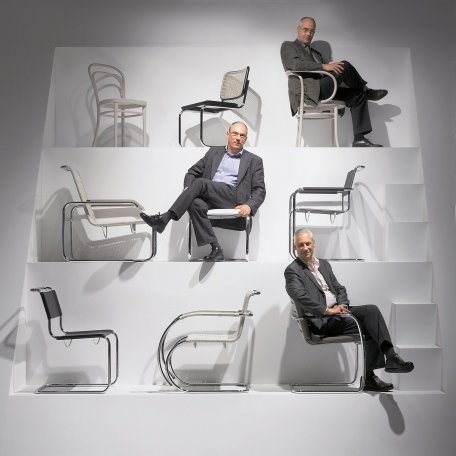
The descendants of Michael Thonet on Thonet chairs

